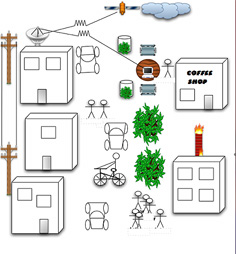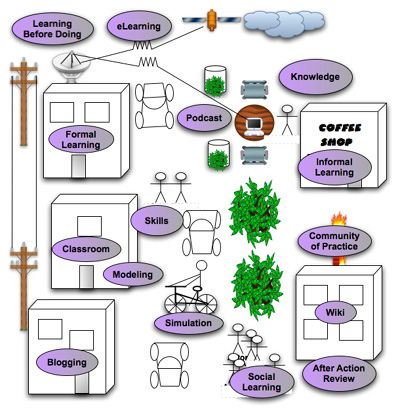
Woonerf is the Dutch name for a "living street" in which the needs of car drivers are secondary to the needs of users of the street as a whole. It is a "shared space" designed to be used by pedestrians, playing children, bicyclists, and low-speed motor vehicles, becoming a public place for people instead of single-purpose conduits for automobiles. In a woonerf, vehicles may not impede pedestrians, who in turn may not unreasonably hinder the progress of drivers.
This "self-reading street" has its roots in design principles that emerged in the 1970s. By dynamically blurring the boundary between the street and sidewalks, woonerfs combine innovative paving, landscaping and other urban designs to allow for the integration of multiple functions in a single street -- the neighborhood shares the road with slow-moving cars. This two-way interaction of people and cars becomes a virtuous circle as the busier the streets are, the safer they become; it seems that when you drive people off the street, that they become less safe.

Good design gives spaces multiple functions, thus training departments that serve a single or limited set of functions, hinder the organization through their wasted spaces. By linking the full gamut of learning processes into a "Learning Woonerf," the organization evolves from a linear learning function into a dynamic uninterrupted slew of learning connections. Thus, unlike a training department, which normally consists of a single space for training, a learning woonerf accounts for all the learning processes, from informal to formal -- the organization truly becomes a "learning organization" rather than just an organization that simply does training.




6 comments:
Saw the post on trdev. I heartily agree, the context of learning has to change. The woonerfs is similar to a concept I and my friends have been thinking about; a community of learning. You seem to have thought of just about everything. The intertia that exists to maintain the staus quo in learning and development is so great that this type of thinking is anathema. What's interesting is that this paradigm is so widely accepted by so many people. We find ways to construct our own personal learning environments based on new technologies and the pressures for us to gain knowledge and mastery.
I teach, therefore I am - Poor.
Doug
Absolutely on target. Hans Morderman, the Dutch traffic engineer who has championed this approach, feels that traditional road signage and lines makes people think of themselves as drivers instead of as people. Take away the signs and lines, and the drivers revert to human status. On average, they drive 16 KPH slower. Accidents in the Netherlands have dropped >50%.
In my book on Informal Learning, I suggest that similarly, we should not coddle people as "learners." Take away their excuse for not learning because "the training was bad."
How much do I love the term Learning Woonerf! I couldn't agree more. As someone who became a Trainer and Manager without the formal degrees I guess I stumbled along the Woonerf til i found where I was going.
Self-study and opportunities like blogs and podcasting offer alternatives far beyond the instructor-led classroom. For an example, you can check out my podcast, The Cranky Middle Manager Show which is listened to by thousands of people around the world... You can hear it at http://cmm.thepodcastnetwork.com
Thanks for helping ME learn something today.
I think we could make great use of these design principles in Australia as well.
Hey Donald,
Great concept and design. Helped me to think and approach the whole learning process from a new perspective. Can you also share your thoughts on how actually this can be translated in to a real-time learning framework in the organizations?
Great work.
Thanks
This site is devoted to giving you all the data available on auto world. Its pretty extensive and I'm sure you'll find what you're looking for here.
Post a Comment